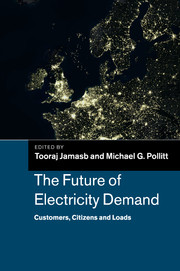Book contents
- Frontmatter
- Contents
- List of Figures
- List of Tables
- List of Boxes
- List of Contributors
- Foreword
- Preface
- Acknowledgements
- Introduction and overview of the chapters
- Part I The economics
- Part II Technology
- 5 Demand-side management and control in buildings
- 6 Smart metering: technology, economics and international experience
- 7 Smart domestic appliances as enabling technology for demand-side integration: modelling, value and drivers
- 8 The scope for and potential impacts of the adoption of electric vehicles in UK surface transport
- Part III Social dimensions
- Part IV Policy and regulation
- Index
- References
7 - Smart domestic appliances as enabling technology for demand-side integration: modelling, value and drivers
from Part II - Technology
Published online by Cambridge University Press: 05 March 2014
- Frontmatter
- Contents
- List of Figures
- List of Tables
- List of Boxes
- List of Contributors
- Foreword
- Preface
- Acknowledgements
- Introduction and overview of the chapters
- Part I The economics
- Part II Technology
- 5 Demand-side management and control in buildings
- 6 Smart metering: technology, economics and international experience
- 7 Smart domestic appliances as enabling technology for demand-side integration: modelling, value and drivers
- 8 The scope for and potential impacts of the adoption of electric vehicles in UK surface transport
- Part III Social dimensions
- Part IV Policy and regulation
- Index
- References
Summary
Introduction
Decarbonization of future electricity systems requires a significant proportion of electricity consumption to be supplied from nuclear, carbon capture and storage (CCS) plant and renewable sources. Since nuclear and CCS plant are less flexible than, for instance, natural gas-fired combined cycle plants, and renewable sources such as wind, solar and tidal are intermittent, this creates serious challenges to the way the current system is operated. In order to ensure that the system is capable of maintaining a supply and demand balance, the reduction in generation flexibility as a result of incorporating more low-carbon generation technologies has to be balanced with an increase in flexibility from demand. Consequently demand-side flexibility needs to be developed and smart domestic appliances can play an important role (IEA, 2008). In order to gain insight and understanding of the role and value of smart appliances, comprehensive studies of its economic value are required. Such analysis needs to consider relevant parameters such as consumers' behaviour and acceptance, appliance technology and future scenarios of power-system development regarding flexibility of generation and network capacity.
This chapter presents a framework to assess the value of smart appliances, as flexible demand, to increase system flexibility and to provide new sources of ancillary services. The increased flexibility will improve system efficiency, reduce operating costs and carbon emissions, and increase utilization of renewable sources; from these benefits the value of smart appliances will be derived. However, any decrease in the value of energy services received as a result of, for instance, inconvenience caused by curtailment or rescheduling of consumption should, in theory, be deducted from such benefits. At the core of the framework is a model that simulates annual system operation, scheduling simultaneously generation and smart appliances, in order to minimize system operating costs. This takes into account system security and operational constraints. In addition, the role of smart appliances to support network operation is studied. Realistic appliance data and results from consumer behaviour studies, as well as wind and demand historical data, are used.
- Type
- Chapter
- Information
- The Future of Electricity DemandCustomers, Citizens and Loads, pp. 185 - 211Publisher: Cambridge University PressPrint publication year: 2011
References
- 5
- Cited by



